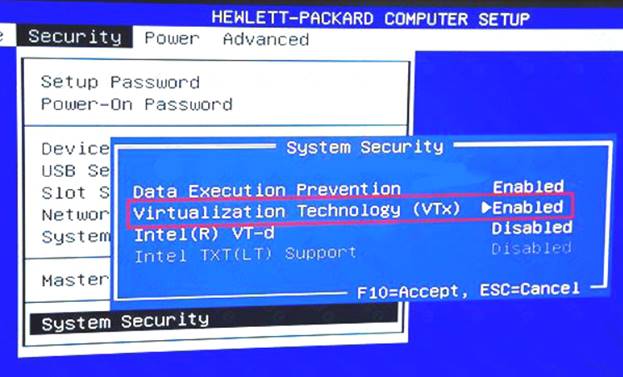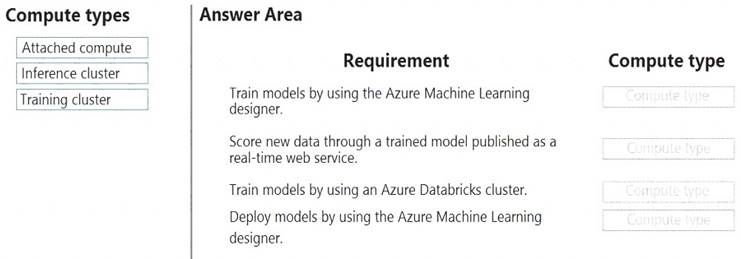- (Exam Topic 3)
You are developing a hands-on workshop to introduce Docker for Windows to attendees. You need to ensure that workshop attendees can install Docker on their devices.
Which two prerequisite components should attendees install on the devices? Each correct answer presents part of the solution.
NOTE: Each correct selection is worth one point.
Correct Answer:
CE
C: Make sure your Windows system supports Hardware Virtualization Technology and that virtualization is enabled.
Ensure that hardware virtualization support is turned on in the BIOS settings. For example:
E: To run Docker, your machine must have a 64-bit operating system running Windows 7 or higher. References:
https://docs.docker.com/toolbox/toolbox_install_windows/ https://blogs.technet.microsoft.com/canitpro/2015/09/08/step-by-step-enabling-hyper-v-for-use-on-windows-10/
- (Exam Topic 3)
Note: This question is part of a series of questions that present the same scenario. Each question in the series contains a unique solution that might meet the stated goals. Some question sets might have more than one correct solution, while others might not have a correct solution.
After you answer a question in this section, you will NOT be able to return to it. As a result, these questions will not appear in the review screen.
You are analyzing a numerical dataset which contains missing values in several columns.
You must clean the missing values using an appropriate operation without affecting the dimensionality of the feature set.
You need to analyze a full dataset to include all values.
Solution: Calculate the column median value and use the median value as the replacement for any missing value in the column.
Does the solution meet the goal?
Correct Answer:
B
Use the Multiple Imputation by Chained Equations (MICE) method. References: https://www.ncbi.nlm.nih.gov/pmc/articles/PMC3074241/
https://docs.microsoft.com/en-us/azure/machine-learning/studio-module-reference/clean-missing-data
- (Exam Topic 3)
You are solving a classification task.
You must evaluate your model on a limited data sample by using k-fold cross-validation. You start by configuring a k parameter as the number of splits.
You need to configure the k parameter for the cross-validation. Which value should you use?
Correct Answer:
B
Leave One Out (LOO) cross-validation
Setting K = n (the number of observations) yields n-fold and is called leave-one out cross-validation (LOO), a special case of the K-fold approach.
LOO CV is sometimes useful but typically doesn’t shake up the data enough. The estimates from each fold are highly correlated and hence their average can have high variance.
This is why the usual choice is K=5 or 10. It provides a good compromise for the bias-variance tradeoff.
- (Exam Topic 3)
You create machine learning models by using Azure Machine Learning.
You plan to train and score models by using a variety of compute contexts. You also plan to create a new compute resource in Azure Machine Learning studio.
You need to select the appropriate compute types.
Which compute types should you select? To answer, drag the appropriate compute types to the correct requirements. Each compute type may be used once, more than once, or not at all. You may need to drag the split bar between panes or scroll to view content.
NOTE: Each correct selection is worth one point.
Solution:
Box 1: Attached compute
Box 2: Inference cluster Box 3: Training cluster Box 4: Attached compute
Does this meet the goal?
Correct Answer:
A
- (Exam Topic 3)
You are using the Azure Machine Learning Service to automate hyperparameter exploration of your neural network classification model.
You must define the hyperparameter space to automatically tune hyperparameters using random sampling according to following requirements: The learning rate must be selected from a normal distribution with a mean value of 10 and a standard deviation of 3.
The learning rate must be selected from a normal distribution with a mean value of 10 and a standard deviation of 3. Batch size must be 16, 32 and 64.
Batch size must be 16, 32 and 64. Keep probability must be a value selected from a uniform distribution between the range of 0.05 and 0.1.
Keep probability must be a value selected from a uniform distribution between the range of 0.05 and 0.1.
You need to use the param_sampling method of the Python API for the Azure Machine Learning Service. How should you complete the code segment? To answer, select the appropriate options in the answer area. NOTE: Each correct selection is worth one point.
Solution:
In random sampling, hyperparameter values are randomly selected from the defined search space. Random sampling allows the search space to include both discrete and continuous hyperparameters.
Example:
from azureml.train.hyperdrive import RandomParameterSampling param_sampling = RandomParameterSampling( { "learning_rate": normal(10, 3),
"keep_probability": uniform(0.05, 0.1),
"batch_size": choice(16, 32, 64)
}
Reference:
https://docs.microsoft.com/en-us/azure/machine-learning/service/how-to-tune-hyperparameters
Does this meet the goal?
Correct Answer:
A

